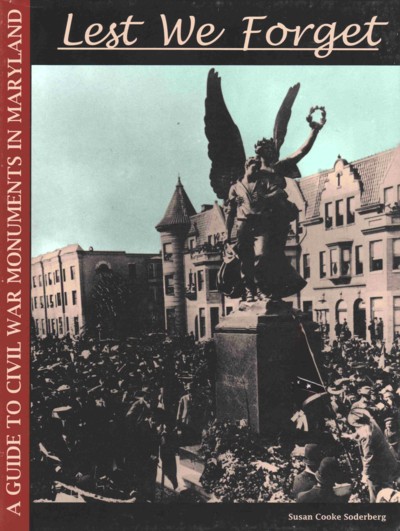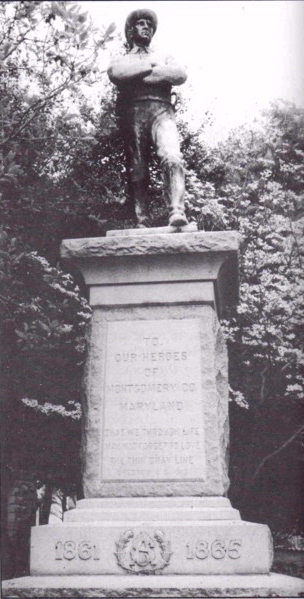
Lest We Forget,
A Guide to Civil War Monuments in Maryland
White Mane Pub. Co., 1995.
Chapter 3 pp. 56-58.
Regional Historian
Account
A history of the County Confederate Memorial, in Rockville by regional author Susan Cooke
Soderburg.
 |
Soderburg, Susan Cooke Lest We Forget, A Guide to Civil War Monuments in Maryland White Mane Pub. Co., 1995. Chapter 3 pp. 56-58. |
Confederate Monument, Rockville
 Confederate veteran Richard Poole Hayes (Co. B,
35th Virginia Cavalry) made the first suggestion that such a monument
be built -- at a memorial service at Monocacy Cemetery in 1906. But no
action was taken until the E. V. White Chapter of the United Daughters of the
Confederacy (U.D.C.) was formed in 1911 .... This group spearheaded the
movement which was joined by the Ridgley Brown Chapter, U.D.C., and the Ridgley
Brown Camp United Confederate Veterans (U.C.V.). Members of the committee
included Hayes, George Rice (1st Maryland Cavalry) and Frank Kilgore
(Co. D, 35th Virginia Cavalry).
Confederate veteran Richard Poole Hayes (Co. B,
35th Virginia Cavalry) made the first suggestion that such a monument
be built -- at a memorial service at Monocacy Cemetery in 1906. But no
action was taken until the E. V. White Chapter of the United Daughters of the
Confederacy (U.D.C.) was formed in 1911 .... This group spearheaded the
movement which was joined by the Ridgley Brown Chapter, U.D.C., and the Ridgley
Brown Camp United Confederate Veterans (U.C.V.). Members of the committee
included Hayes, George Rice (1st Maryland Cavalry) and Frank Kilgore
(Co. D, 35th Virginia Cavalry).
After $3,600 was raised through charity events and public subscription, Michael J. Falvey of Washington was hired to construct the monument which was, according to the E. V. White Chapter, "to honor our soldiers in this county who left home and firesides to cast their lot with the Southland, and to be an inspiration to the youth of our land to hold principle, honor, and a firm trust in God above all else."
Falvey Granite Company was found by Michael J. Falvey (1859-1921) in 1886 after he had been working as a stonemason on the Washington Monument. The company, located near Rock Creek Cemetery in Washington D.C., specialized in cemetery monuments and usually the artist would make a small model in plaster which would then be transferred to stone by a stonemason. In the case of a bronze statue such as this, however, the artist would have made the model full size in order to have it cast by a foundry. Although the Falvey Company is still in operation, records before 1927 no longer exist. The 1993 owner, Merle L. Cox, Jr. thought that the artist for this statue may have been Fred E. York, a well-known monument artist who is known to have worked for the company in the 1920s and 1930s.
The monument is life-size bronze of a cavalry private, arms folded and looking into the distance, standing on an eight-foot granite pedestal. The model for the statue was reportedy Spencer C. Jones who had been a private in Company A, 1st Maryland Cavalry, and had gone o\n to become a prominent politician in Montgomery County. .... The monument was placed in front of the county courthouse, facing south, and was unveiled June 3, 1913.
The dedication ceremony for this monument was a dramatic demonstration of the reconciliation stage of monument building. It climaxed with the unveiling of the monument that had been draped with the Confederate and Maryland flags. When those flags were pulled down, an American flag was unfurled to fly above the statue in the breeze to the accompaniment of the band playing "Dixie", and then the "Star Spangled Banner."
The Montgomery Sentinel (June 6, 1913) reported that the location was
... almost within a stone's throw fo the place where our Revolutionary fathers gathered to express their repudiation of the assumed right of Great Britain to levy taxation on our people without representation.... More than three thousand souls assembled to do homage to those who, dominated by a like courage and patriotic spirit, voluntarily enlisted in the cause of the South.
The speakers stood on the courthouse porch while 50 to 75 veterans lined the sidewalk in front, facing the audience. The band played "Maryland, My Maryland," and the Judge Edward C. Peter gave the welcomeing address in place of Spencer C. Jones who was ill. He named the Confederate officers from the county and spoke of the courage and importance of their service, and of the men who served under them. There was an invocation by Reverend James Taylor of the Presbyterian church of Washington D.C., and then a choir sang, "Nearer, My God, To Thee." The Honorable J. Thomas Helflin from Alabama was the featured speaker. He spoke of the gallantry of the Confederate soldiers and the hardships they endured and their devotion to a cause which was never lost, only overpowered. He pointedly defended the soldiers as not being traitors, and ended with a tribute to the "fortitude and majestic loyalty" of the women of the South. As the newspaper recorded, "one of the most pathetic scenes of the day occurred when the veterans present responded in tears to the sentiments of the speaker."
In 1971 the monument was moved to the side of the old courthouse to make way for an urban renewal project. It is surrounded by tall bushes.